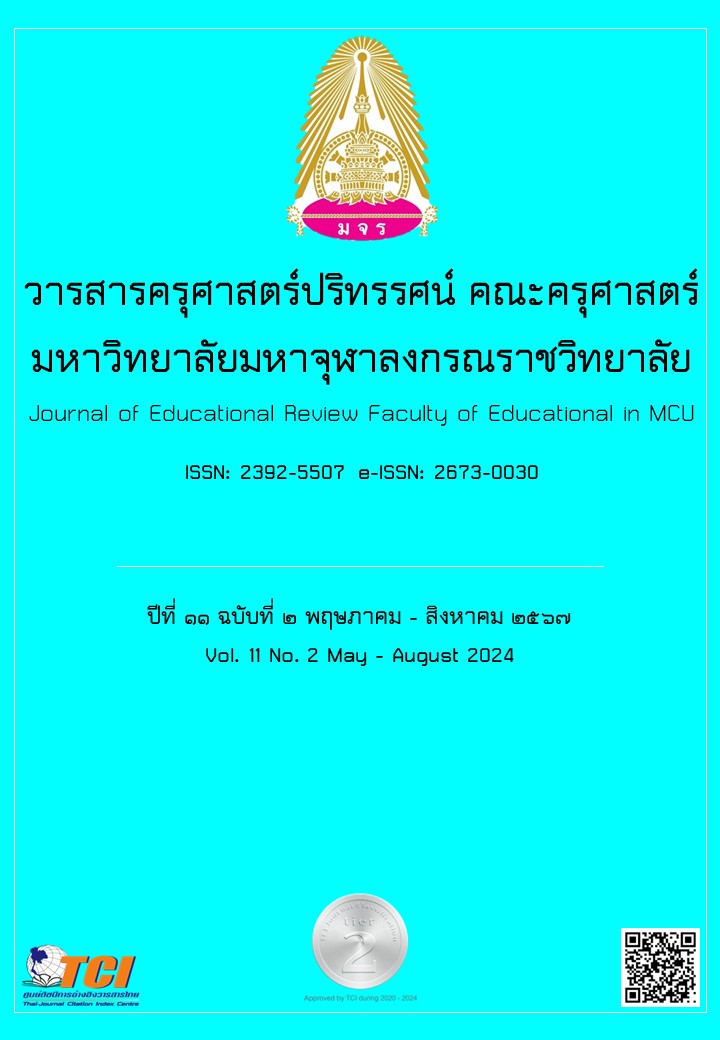EFFECT OF LEARNING MANAGEMENT USING TALES AND AUGMENTED REALITY TECHNOLOGY WITH KWL PLUS TECHNIQUE TO ENHANCE GEOGRAPHY ABILITIES OF GRADE 2 STUDENTS
Main Article Content
Abstract
The purposes of this research were to develop learning management using stories and augmented reality technology with the KWL PLUS technique to strengthen the geography abilities of Grade 2 students and to strengthen the geography abilities of Grade 2 students by social learning activities using the KWL PLUS technique together with stories and augmented reality technology. It is quasi-experimental research. There was a single experimental group measured before and after learning. The instrument used to collect data was the lesson plan of using stories and augmented reality technology with the KWL PLUS technique to strengthen the geography abilities and geography abilities test. Data was analyzed by means, standard deviation, The efficiency value of learning management by using the KWL PLUS technique together with stories and augmented reality technology. The proportion was set to be 80/80 and the statistical test was t - test Dependent. The finding of this research found that the efficiency of learning management using stories and augmented reality technology with the KWL PLUS technique to strengthen students' geographic abilities of Grade 2 students, the results of the total average were 21.17, the efficiency during study was 88.19, and the students did the posttest and the result of the total mean was 16.70, the post-study efficiency value was 83.50, which is in line with the efficiency score that was set in the proportion of 80/80. And Students' ability in geography was higher after studying than before, with statistical significance at the .05 level.
Article Details

This work is licensed under a Creative Commons Attribution-NonCommercial-NoDerivatives 4.0 International License.
ทัศนะและความคิดเห็นที่ปรากฏในบทความในวารสารฉบับนี้ถือเป็นความรับผิดชอบของผู้เขียนบทความนั้นเพียงผู้เดียว และไม่ถือเป็นทัศนะและความรับผิดชอบของกองบรรณาธิการ
กองบรรณาธิการขอสงวนสิทธิ์ในการคัดเลือกบทความลงตีพิมพ์และจะแจ้งให้เจ้าของบทความทราบหลังจากผู้ประเมินบทความตรวจอ่านบทความแล้ว
ต้นฉบับที่ได้รับการตีพิมพ์ในวารสารครุศาสตร์ปริทรรศน์ คณะครุศาสตร์ มหาวิทยาลัยมหาจุฬาลงกรณราชวิทยาลัย ถือเป็นกรรมสิทธิ์ของคณะครุศาสตร์ มหาวิทยาลัยมหาจุฬาลงกรณราชวิทยาลัย ห้ามนำข้อความทั้งหมดหรือบางส่วนไปพิมพ์ซ้ำ เว้นเสียแต่ว่าจะได้รับอนุญาตจากมหาวิทยาลัยฯ เป็นลายลักษณ์อักษร
References
กนก จันทรา. (2561). การรู้เรื่องภูมิศาสตร์ Geo-literacy learning for our planet: ถอดบทเรียนประสบการณ์การจัดการเรียนรู้ภูมิศาสตร์ในชั้นเรียนที่เสริมสร้างการรู้เรื่องภูมิศาสตร์. กรุงเทพมหานคร: สำนักพิมพ์แห่งจุฬาลงกรณ์มหาวิทยาลัย.
ธัญญารัตน์ แก้วตะพาน. (2563). วารสารวิชาการศรีปทุม ชลบุรี. 17(1). 148-158.
พนิดา ตันศิริ. (2553). โลกเสมือนผสานโลกจริง. วารสารนักบริหาร. 30(2). 169-175.
พีรพงศ์ จ้อยชารัตน์. (2564). การศึกษาความสามารถทางภูมิศาสตร์โดยใช้การจัดการเรียนรู้ กรณีศึกษาร่วมกับกระบวนการทางภูมิศาสตร์ของนักเรียนชั้นมัธยมศึกษาปีที่ 6. วิทยานิพนธ์การศึกษามหาบัณฑิต. มหาวิทยาลัยศิลปากร.
ไพฑูรย์ ศรีฟ้า. (2556). พลิกบทบาท 3D สู่โลกความจริงเสมือน (Augmented Reality). นครปฐม: ภาควิชาเทคโนโลยีการศึกษา คณะศึกษาศาสตร์ มหาวิทยาลัยศิลปากร.
มนัสนิต ใจดี และจรัญ แสนราช. (2559). การพัฒนาระบบตามรูปแบบการเรียนรู้แบบปัญหาเป็นฐานร่วมกับเทคนิค เค ดับเบิ้ลยู แอล พลัส ที่มีระบบเสริมศักยภาพเพื่อพัฒนาการคิดอย่างมีวิจารณญาณ. วารสารศรีนครินทรวิโรฒวิจัยและพัฒนา (สาขามนุษยศาสตร์และสังคมศาสตร์). 8(16). 1-15.
ยุณีย์ กอนพ่วง, วิไล เอมพรหม และสรัลยา คงหนองลาน. (2561). การพัฒนาการจัดกิจกรรมเล่านิทานตามกระบวนการของคอล์ปที่เสริมสร้างวินัยมนตนเองของเด็กปฐมวัย. สารนิพนธ์การศึกษามหาบัณฑิต. มหาวิทยาลัยนเรศวร.
ระพีพรรณ พัฒนาเวช และคณะ. (2553). คู่มือการคัดเลือกหนังสือสำหรับเด็กแต่ละช่วงวัย. แหล่งที่มา https://www.tkpark.or.th/stocks/extra/000597 สืบค้นเมื่อ 17 ก.ย. 2565.
วัชรา เล่าเรียนดี. (2547). เทคนิควิธีการจัดการเรียนรู้สำหรับครูมืออาชีพ. นครปฐม: มหาวิทยาลัยศิลปากร.
วิชัย วงษ์ใหญ่ และมารุต พัฒนผล. (2563). จากการเรียนรู้ออนไลน์สู่การสร้างนวัตกรรม. กรุงเทพมหานคร: ศูนย์นวัตกรรมหลักสูตรการเรียนรู้ บัณฑิตวิทยาลัย มหาวิทยาลัยศรีนครินทรวิโรฒ.
วิวัฒน์ มีสุวรรณ์. (2556). การออกแบบและพัฒนาสื่อการเรียนรู้ด้วยเทคโนโลยีออคเมนเต็ดเรียลลิตี้ Augmented Reality. เพชรบูรณ์: จุลดิศการพิมพ์.
สำนักงานกองทุนสนับสนุนการสร้างเสริมสุขภาพ. (2565). เด็กได้ 9 คุณค่าจากการฟังนิทาน. แหล่งที่มา https://www.thaihealth.or.th/?p=235341 สืบค้นเมื่อ 17 ก.ย. 2565.
สำนักวิชาการและมาตรฐานการศึกษา. (2560). ตัวชี้วัดและสาระการเรียนรู้แกนกลางสาระภูมิศาสตร์กลุ่มสาระการเรียนรู้สังคมศึกษา ศาสนาและวัฒนธรรม (ฉบับปรับปรุง พ.ศ.2560) ตามหลักสูตรแกนกลางการศึกษาขั้นพื้นฐาน พุทธศักราช 2551 และแนวการจัดกิจกรรมการเรียนรู้. กรุงเทพมหานคร: โรงพิมพ์ชุมนุมสหกรณ์การเกษตรแห่งประเทศไทย.
อัญญา บูชายันต์, วนมพร พาหะนิชย์ และภูมิ สาทสินธุ์. (2561). เทคโนโลยีภูมิสารสนเทศกับการรู้เรื่องภูมิศาสตร์. วารสารคณะมนุษยศาสตร์และสังคมศาสตร์ มหาวิทยาลัยราชภัฏสุรินทร์. 20(ฉบับพิเศษ). 385 – 397.
Aaron Shepard. (2013). The Business of Writing for Children, Shepard Publications. Form http://www.aaronshep.com/kidwriter/Tips.html Retrieved April 3, 2021.
Agarwal Rangnath, R. (2015). Social studies, literacy, and social justice in the common core classroom: A guide for teachers. Teachers College Press.
Bustin, R., Butler, K. & Hawley, D. (2017). Geocapabilities: teachers as curriculum leaders. Teaching Geography. 42(1). 18-22.
Carr, E. & Donna Ogle. (1987). K-W-L Plus : A Strategy for Comprehension and Summarization. Journal of Reading. 30. 626–631.
Edelson, D. C. (2011). What is geo-literacy. National Geographic. Form http://education.nationalgeographic.com/education/media/what-is-geo-literacy Retrieved September 15, 2020.
Kamburov, A., Slavova, T., Nemska, T. & Karshev, D. (2016). Enhancing geo-literacy: cloud-based gis as inovative informal educational tools. in 6th international conference on cartography and gis.
Lois E. Huffman. (1998). Source Spotlighting Specifics by Combining Focus Questions with K-W-L. Journal of Adolescent & Adult Literacy. 41(6). 470-472 .


